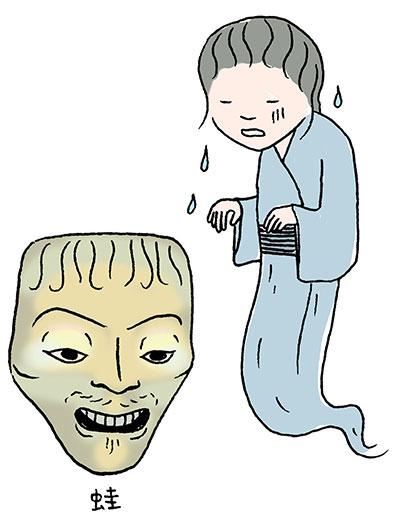
There is a Noh mask that is said to have “photographed the face of the dead”. that is “Kawazu”. It is Noh mask which was said that Etchu (Toyama Prefecture), a priest of Jonichiji Temple, and Nikko (also known as Munetada Himi) in the Muromachi period struck the corpse. The truth is unknown, but it is certain that he had many chances to die because of his occupation as a priest.
The songs in which Kawazu are used are mainly those depicting the dead suffering from hell, such as “Fujito,” “Akogi,” and “Zenchitori.” Compared to the “thin man” who is used in a similar way, the Kawazu has wet hair and is even more miserable. It is a perfect Noh mask for Fujito, where the dead people appear.
In addition to thin man and Kawazu, “Kagekiyo,” “slim woman,” and “dragon woman” remain in Noh mask, which is said to be made by Nissho. All of them are characterized by their jealousy and regret, and they have an expression of agony, and it seems that they were the best in the world if they hit such a “thin face”.
While being regarded as one of the “ten works”, which is a general term for excellent face-to-face (there are various theories), their unique style influenced later literary figures. There are many novels inspired by the ice, such as Taijun Takeda’s “Stairs of the Aristocrats” and Sonoko Sugimoto’s “Rin’s Score”.
In addition, the representative female face “Sonjiro” that is handed down in the Kongo style is said to have been struck in memory of his wife, who died at a young age, by Tayu Kongo Ukyo Kuji (common name: Sonjiro), who was said to have been active in the late Muromachi period. , The main name is “Yomokage”.
It has a calm look that is a little older than the “small Noh mask” that represents a young woman, and it is said that its structure is closer to that of a human being. Sonjiro seems to be often used in “Matsukaze” and “Izutsu” who think of their loved ones even if they become ghosts.
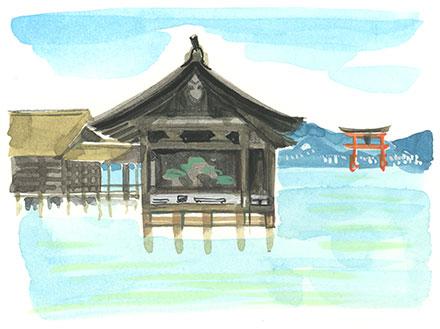
Currently, there are about 80 Noh theaters in Japan, as long as they can accommodate a certain number of spectators. Each has its own personality, but the Noh stage at Itsukushima Shrine in Hiroshima, which is surrounded by the sea on all sides, is a must-see. At high tide, you can see the stage as if it were floating in the sea. One of the features is that the angle of the bridge is steep, similar to the stage that was said to have been in the Edo Castle Honmaru. Therefore, it is difficult to see the direction of the bridge from the Fuekata- whistle, and it seems that the “Nanori Fuekata” that matches the timing with the appearance of the Waki may be blown out depending on the intuition. There is also such an anecdote. There was a Noh actor named Kitayu Udaka, who was known for his accurate footsteps. At one point, a carpenter who was involved in the renovation of the stage hit his foot because he had thickened the shite pillar, and since then this shite pillar has come to be called the “Kitayu pillar”.
Noh stages are also concentrated in the Kinki area. The Hikone Castle Noh Stage, which still exists in the castle, the Kita Noh Stage at Nishi Honganji Temple in Kyoto, which is the oldest in Japan (closed in principle), and the Kongo Nogakudo, the home of the Kongo style. Kongo Nogakudo is a new facility that was relocated from Muromachi, Kyoto to Karasuma Ichijo in 2003, but it retains the remnants of the forbidden Noh that was inherited from the old Kongo Noh stage, including the Qinghai wave pattern on the wall of the bridge, and the bamboo blinds and shoji screens.
Illustration: Hiroko Sakaki
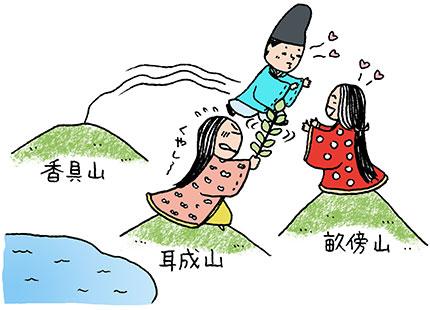
Japan has more than 70% of its land area occupied by mountains. The custom of collectively referring to three representative mountains of each land, such as “Dewasanzan” and “Kumanosanzan”, has taken root in various places. Yamato (Nara Prefecture) has “Yamato Sanzan”, that is, Mt. Amanoka, Mt. Unebi, and Mt. Miminashi.
Yamato Sanzan has been the subject of waka poems for a long time. The head of “Mt. Amanoka is a ridge and Miminashi …” written in the Manyoshu is a song associated with the legend that “personified” Miyama. The content is that Mt. Unebi (female) and Mt. Miminashi (female) fights over Mt. Amanoka (male).
The Noh play that covered this legend is “Mitsuyama”. When the husband went to his wife for a “go-to-marriage”, a man named Kiminari who lived in Mt. Amanoka and two women, Katsurago of Mt. Miminashi and Sakurago of Mt.Unebi . He went to two women every night. Katsurago is the first wife and Sakurako is the second wife. One day, the man began to go to his second wife, Sakurako. Katsurago, who mourned the man’s change of heart, threw herself into the pond, became a ghost, appeared in front of the traveling priest, and asked for mourning. When the monk turns around, the ghosts of Katsurago and Sakurako appear. Katsurago hits jealousy and resentment, and beats Sakurako with the branches of Katsura. The resentment is clear, and the two wish to reincarnate in the Pure Land while receiving the monk’s Nembutsu.
The behavior of the ex-wife to jealousy the second wife in this way is called “rear-wife (uwa-nari) striking” and is a custom that actually existed from the late Heian period to the early Edo period. It is expressed elegantly in Noh, but as the times went down, it seems that both the former wife and the latter wife became more radical, calling each other’s friends and fighting.
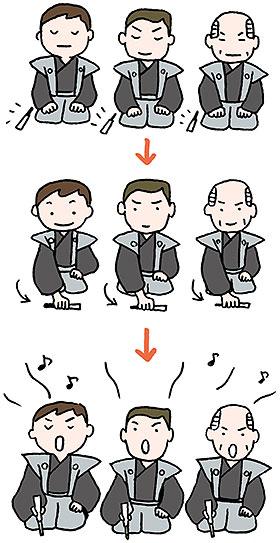
The fan is one of the most important tools for Noh actors. All actors, including the three roles of Waki, Kyogen, Hayashi musicians, Chijitai and Kouken, as well as shite and tsure, will go on stage with a fan.
Please pay attention to the movement of the Chijitai. For those who enter through the cut door, first sit in a fixed position (Jiyoza) and place the fan on the right side of the body. Next, slide the fans all at once to the front of their knees and wait in that state. When it becomes a part of the Jiutai song, they pick up the fan and start singing together.
Why do they put the fan in front of their knees and wait? It is believed that this is to draw a boundary between Shite, Waki and the Jiutai singer, and to create a barrier. When distinguishing the Noh stage into two spaces, the fan separates the boundary.
Noh is not the only thing that gives a fan a special role. In Japanese dance and tea ceremony lessons, it is common to sit upright and put a fan in front of them to give a bow. This is also thought to be an act of humility to be in a lower place by drawing a line between the teacher and the disciple with a fan.
Illustration: Hiroko Sakak
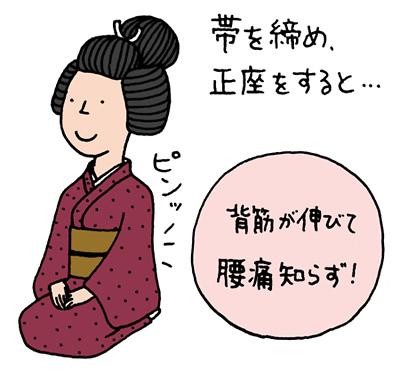
It is said that Japanese people in the old days had less back pain. The reason for this is the traditional Japanese customs such as “Seiza” and “Tightening the obi”. When you tighten the obi, your spine will grow naturally. This is because the belt tightens the pelvis and the centerline of the body from the head to the spine to the waist is firm. Today, the obi plays a role similar to the waist band used by people with back pain.
And Seiza. Seiza is a Japanese way of sitting that was popular among the samurai class in the Edo period, but since the buttocks fit on the legs, the line of the body that runs from the head to the spine becomes a straight line, and the posture is naturally good. Become. As a test, try sitting upright in a bad posture (such as squeezing or leaning forward) when sitting in a chair. On the contrary, it will be painful. When the posture is extended, the burden on the lower back is lessened, it becomes easier to be aware of Tanda, and the abdomen is stressed without difficulty.
In old China, the basics of health were called “upper imaginary reality”. “Upper” is the head, “lower” is the lower abdomen (Tanda), “imaginary” is the none, and “real” is full. A life that rests your head and fills your lower abdomen is a source of energy and longevity. The former Japanese, who used to wear obi and sit upright, practiced a health method that naturally cares for the waist.
Even in Noh, when you wear a kimono, fasten your obi, and sing a song, you should sit upright. The vocalization of the chanting is made from the belly, but many of you may have the experience that when you sit upright, your belly naturally becomes calm and it becomes easier to vocalize. Noh can be said to be “effective for back pain.”
References :
” Physical method to create a body that does not get tired” by Noboru Yasuda, published by Shodensha
Illustration: Hiroko Sakaki
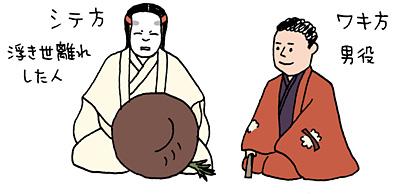
There are some rules for Waki. First of all, it is the opponent of the main character, Shite. Both Waki and WakiTsure are almost male roles. And never put on the Noh mask. Although Noh is a masque, it is a rule that the important performer of the stage, Waki, does not face it, but rather does not. This is because the Waki is depicted as a real living person. He is the opposite of the shite, so to speak, he plays the role of standing on the same side as the audience.
Noh performances represent a wide variety of worldviews. Shite sometimes appears as an unrealistic dream or illusion, and sometimes violently as a real human being similar to a Waki. Sometimes it’s face-to-face, sometimes it makes a Noh mask.
In this way, the stage of Noh changes in various ways depending on the role of the shite. It may be that the reason why it is firmly established as a series of stage plays is that it helps the Waki to mediate and share the audience and the world created on the stage.
Illustration: Hiroko Sakaki
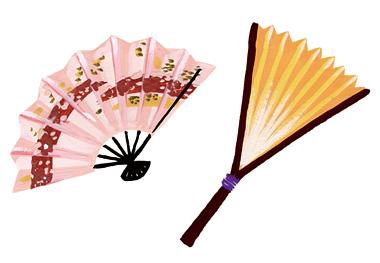
Folding fans were born in Japan and spread all over the world. Originally, paper was pasted on only one side of the bone, but in China, the one pasted on both sides was reimported to Japan, and a unique folding fan was born in which the bone was inserted between the papers.
Fans are important in Noh. Everyone on the stage has a fan in their hands (there are exceptions), but the one that the shite is holding and spreads out without closing is called “Chukei”. The word “Suehiro” is said to describe this fan’s closed form.
A fan that closes as usual, which is used in a dance, or is picked up by Jiutai kata, hayashi musician, or kouken kata, is called a “Shizume Ougi”. Specifications such as the structure of the fan bones and the pattern on the surface vary slightly depending on the style Noh. Just like the faces and costumes, look carefully.
Illustration: Hiroko Sakaki
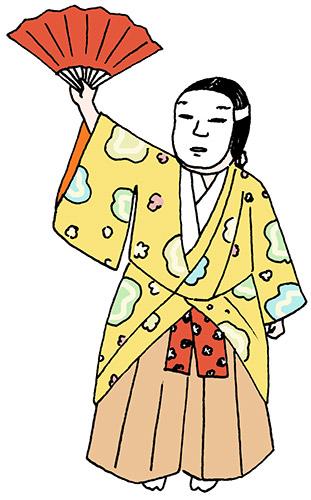
Noh has a number of “types” that use fans to express various meanings.
The “Kazashi fan” is a type that holds the main part of the fan with your right hand and holds it high, but this is an action that looks out into the distance. “Tsukino-Ogi” is the one that attaches an open fan to the left shoulder and looks up diagonally to the right. “Hane-fan” is a fan that holds the base paper part of one of the ribs (thick bones at both ends) of the spread fan with the left hand, puts it on the right shoulder, and then bounces it forward. This represents the way things sway, and when expressed strongly, it means shooting an arrow, and when done softly, it also makes the celestial maiden’s clothes flutter. “Yuken” is an act of flipping a fan upwards, expressing a clear feeling.
The fan sometimes expresses the emotions of the performer in detail, and sometimes it plays a role in broadly describing “things” such as cups and brushes, and “natural appearances” such as wind and waves. If you look at Noh while thinking about what the movement of the fan represents, you can go deeper into the world that Noh depicts.
Illustration: Hiroko Sakaki
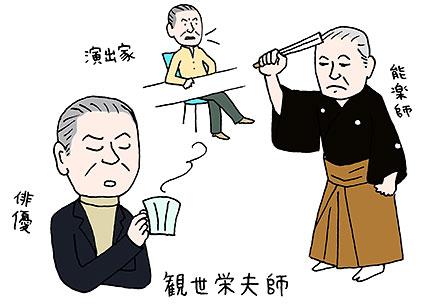
There are five styles of Noh play, and even if the performances are the same, there are small differences in dialogue and patterns. In the past, there were times when the barriers between styles were high, and when taking an amateur disciple, some Noh performers wrote a memorandum such as “they will not move to another style.”
On the other hand, during the Edo period, Noh actors sometimes changed their style at the will of the feudal lord. The Kaga Maeda clan is a typical example. The area is so popular that the word “Kaga Hosho” remains, but the feudal lord, Toshiie Maeda, actually liked the Kinshun school. It is said that the fifth feudal lord, Tsunayoshi, was influenced by the Hosho style of Shogun Tsunayoshi Tokugawa and forced many Noh actors to change.
Hideo Kanze is an example of a recent transfer of himself. Born in the Kanze Tetsunojo family, he has been practicing since childhood, but after careful consideration, he turned to the Kita style, saying, “I was fascinated by the method of creating the Kita style body.” Later returned to the Kanze school). He deepened his interest in shingeki_new performances and opera, and was active not only in the Noh world but also in various fields as an actor and director. In addition, Masanori Kusukawa, who studied under Ukyo Kongo, changed from the Kongo style to the Kanze style shortly after the war.
In addition, for example, it is quite common to be born in a house of musicians or kyogen and become a shite.
From ancient times, there have been cases where adopted children were adopted from other styles of the Tayu family, such as from the Kanze family to the Hosho family, from the Hosho family to the Kanze family, and from the Kongo family to the Hosho family. It may be called a commutation, but this is to keep the style. It was a sign of mutual help between Noh actors.
Illustration: Hiroko Sakaki
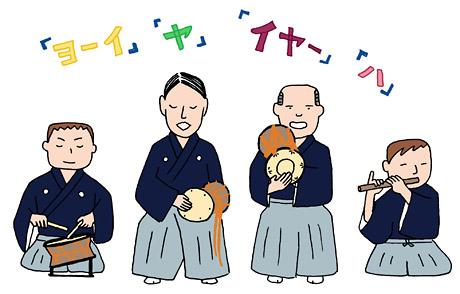
It is a shout that the Hayashi musicians, each playing facing the front, need to check each other’s progress. Basically, there are four types of shouts, “ya”, “ha”, “yoi”, and “iya” for each beat, and various expressions are made while changing the strength and tone of the vocalization depending on the atmosphere of the song.
This shout is important not only for the Hayashi musicians but also for the performers as a signal of performance. However, the Hayashi musicians and performers do not “match” the stage together based on the shouts, but rather grasp the expression intended by the other party and hit their own expression against it, so that the tension is not felt. However, the stage of the once-in-a-lifetime meeting will be created.
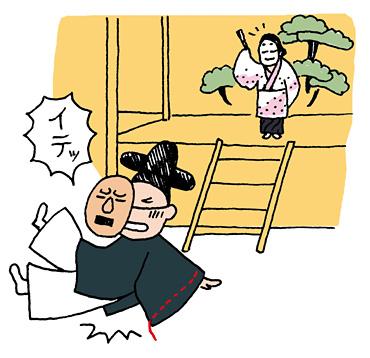
It is very rare for a performer to fall off the stage. Especially when the surface is attached, the field of vision is extremely narrow and you cannot see your feet. It is confirmed by the position of the pillars and the number of steps, but it seems that the idea may be wrong at Noh stages and special venues with different dimensions.
The Noh stage cannot be interrupted in the event of any accident. In principle, even if the performer falls off the stage, the performer returns to the stage without rushing and continues as if nothing had happened.
In the unlikely event that the performer is unable to continue, the Kouken Kata will usually act as a substitute on the spot and continue the performance.
Illustration: Hiroko Sakaki
The Noh stage begins without notice of the start and ends with a lingering finish without the end of the performance. Everything that happens on the stage during that time becomes the object of Noh, and it can be said that the stage has a high degree of freedom on the part of the viewer.
Quietness is also an important factor for some people. Talking is out of the question, but even commentary to deepen the understanding of the companion requires consideration for the surroundings. Coughing is only due to physical condition, but the Noh theater is air-conditioned, so be sure to bring a mask and be considerate of your surroundings.
You don’t have to be particularly clever about your clothes. However, although young people are increasingly enjoying hats as fashion, do not wear them during Noh unless there are special circumstances.
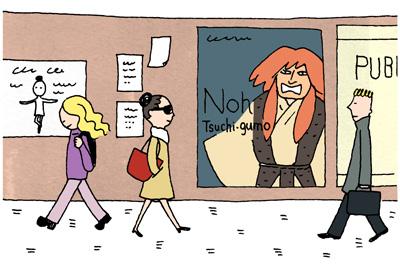
It is not clear when Noh was first performed outside of Japan. Originally, Noh is a performing art that has its origins overseas. In addition, there was considerable exchange between Japan and other countries from the Muromachi period, when Noh was completed, to the early Edo period, when the policy was changed to isolation. Considering these, it is possible that Noh was performed overseas at an unexpectedly early stage after Zeami, even if it was not recorded.
By the way, after the opening of the Meiji era, records and reports of overseas performances can be seen all at once. In 1905 (Meiji 38), in Seoul, the Korean Empire at that time, Noh orchestras including the Kanze Soke played Noh Noh Ichiban, Kyogen Hachiban, and Maiko Ichiban. After that, Noh seems to have been performed many times in various regions of East Asia. On the other hand, as for Europe and the United States, there is a record that Noh performed at the “Japanese Performing Arts Tournament” held in London, England in March 1900 (Meiji 33). There is also a report that a Noh performer from the Kanze school stayed in San Francisco from the end of the Taisho era to the beginning of the Showa era and played Noh. However, it is uncertain whether these performances in Europe and the United States were true, and whether they were full-fledged with all the faces, costumes, and three roles.
After World War II, the first full-scale Western performance recorded was the invitation to participate in the “Venice International Theater Festival” held in Venice, Italy in 1954 (Showa 29). The group consists of 15 people, including Minoru Kita, the leader of the group, 10 people from the shite, and 5 people from the musicians. A gorgeous program and stage in three languages, English, French and Italian, was also prepared in Japan.
The stage is designed by a stage set artist and produced by Kabuki props. In addition to removing the pillars, the length and angle of the bridge can be adjusted, and it was disassembled and assembled so that it could be used for subsequent performances in Western countries, but it seems that it is now for three trucks. He left Japan a month early and was assembled on the orchestra box of a local stone amphitheater. The performances have been highly acclaimed, and some of the performances will be broadcast to Zeni on TV, and the success of this performance will lead to the establishment of subsequent overseas performances of Noh.
References:
Reprinted and expanded version of “Noh Rise and Fall” by Nobuyoshi Ikeuchi, Tokyo Sogensha “Exotic Henro Traveling Performers Disposal”
by Kenji Miyaoka
, Chuko Bunko “History of Noh Overseas Performances” edited by Kazuyoshi Nishi and Tamotsu Matsuda Kinshosha

Sarugaku Noh, which was established during the Muromachi period, had a lot of influence on the performing arts of posterity in Japan. Kabuki is a good example. “Kanjinchō”, one of Kabuki Jyuhachiban, is an adaptation of Noh’s “Ataka”. “Funa Benkei” and “Tsuchigumo”, which were also born from Noh, and “Kyogen” and “Zazen meditation” inspired by Kyogen are collectively called “Matsuhamemono” or “Nohtorimono”. Matsubame is a Kabuki term for a Kagami Ita. When performing Matsuba-memono, an old pine tree is drawn in the background, following the Noh stage.
Incorporating Noh which was enjoyed by Noh of Shogunate, a folk performing art, into Kabuki because a folk performing art, would have been difficult in the age of the social division system. However, Noh also influenced rakugo, which can be said to be popular. In the rakugo story “Takasagoya,” Yatsuan, who was asked to be a wedding matchmaker, will be struggling to perform the song “Takasago” as a congratulatory message. Although the common people of Edo had few opportunities to see Noh directly, it can be seen that they were familiar with the world of Noh through the songs.
Illustration: Hiroko Sakaki
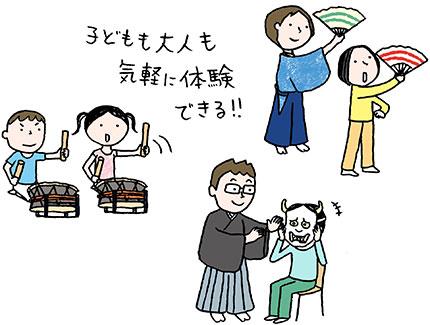
Did you know that you can learn Noh? Noh became a samurai ceremony during the Edo period. Unlike Kabuki, there were few opportunities to see the stage, but it became popular among the common people through chanting. Its prosperity can be compared to modern karaoke. Even such prosperity falls into a crisis of decline in the early Meiji era, but when the crisis is lifted with the support of Tomomi Iwakura, the practice of chanting and chanting will be practiced by Chinese people, business owners, officials, educators, etc. It has become established as a joy for people, centered on.
Nowadays, like Japan’s tea ceremony and flower arrangement, anyone can learn as a kind of lesson. Except for the Iemoto(Noh Family’s things) and some Noh performers, many of the shite, Waki, kyogen, and hayashi musicians offer lessons. What is taught is basically the same as what a professional plays in production, such as chanting, dance, kyogen, and hayashi. By studying deeply, it is possible to acquire the ability to be taught from a professional standpoint. In fact, some have turned from ordinary people to professionals.
If you feel that the threshold is high, why not take part in hands-on lectures held at Noh theaters and rental halls around the world. There are also courses for children, and Kyogen with comical movements and large drums, small drums, and drums that are relatively easy to make sounds are especially popular.
For those who want to learn in earnest or who are busy, we recommend individual lessons with flexibility in time and place. It is not uncommon for Noh performers to disseminate information on blogs and SNS, mainly young people. It should also be available for tours.
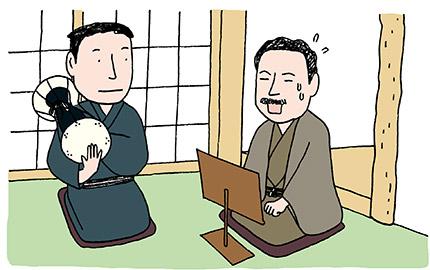
In Natsume Soseki’s masterpiece “I am a cat”, there is a story about the protagonist’s cat talking about the protagonist’s propensity, but the episode of the song is cited there. He wants to sing aloud in the back rack (toilet), and even if He gets the nickname “back rack teacher” in his neighborhood, he doesn’t mind. It is ironic that Kumano’s passage, “This is Taira no Munemori,” is repeatedly mistaken as “This is Taira no Munemori,” and he is laughing. Also, in “Kusamakura”, you can see scenes that you would like to think of this trip as Noh, and descriptions of specific Noh such as “Seven Knights”, “Sumidagawa”, and “Takasago”.
Soseki began to become familiar with the Hosho style chanting, which was popular among professors when he was assigned to Fifth High School in Kumamoto. The episode of “Mr. Gokake” is also based on the actual experience at that time. After that, after being interrupted by studying abroad in the UK, He began to learn chanting from the Iemoto Hosho Shin of the Wakikata Shimokake Hosho style with the introduction of Kyoshi Takahama. According to his wife, Kyoko, Soseki liked chanting and sang well. He often appeared and sang at volunteer training sessions.
What was Soseki’s song like? When He explored the surrounding area, Torahiko Terada said, “If I said that the teacher’s song was a tongue, I would always remember to say something terrible.” “It was a target,” Yaeko Nogami said, “I can’t raise the score with a sweet, sweet, goat-like song,” and Yoshishige Abe said, “I was dexterous, but I was daring and not very obsessed.” It was the first time, “said his teacher, Shin Hosho,” What is interesting is that the song of Mr. Soseki, who has a strict personality, was very varied. “
In “New Year’s Day” in the work “Eijitsu Shohin”, when the disciples visited for New Year’s greetings, Soseki sang a song with Kyoshi Takahama’s drum, and he was surprised because he faced the drum for the first time. The story that it has been done is interestingly spelled out. It can be seen that Noh was very familiar to the cultural people of the Meiji era.
Illustration: Hiroko Sakaki
From the answer, I don’t understand, but it seems to be a common theory. It is so old that it is difficult to understand from the records why it came to be called. The oldest record of “Noh” as a play is said to be in the middle of the 14th century ( * ). Until the end of the Edo period, both words were used for “Noh” and “Sarugaku.” The word “Noh” comes from the Meiji government’s “Noh-sha”, which was born as an organization responsible for the protection of Noh actors, and is a modern name. Thinking about the meaning of the name “Noh” may be asking what is Noh.
( * ) Reference material “Contemporary Noh Music Lecture” by Fumio Amano (Osaka University Press)
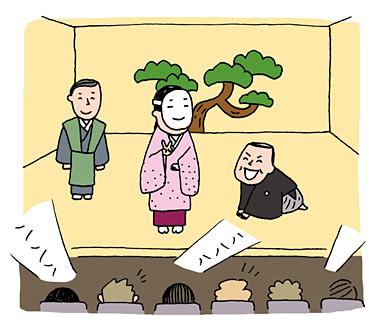
In Noh, the techniques that actors and players have trained and acquired in their respective roles and traditions of the style to which they belong are expressed on the stage. On the stage where the best expressions are collaborated with each other, there is a sense of tension that is not even a little skimpy, and a deep world view is shown.
There is an exceptional form of Noh that departs from the essence of such Noh. It is called “Ranno” and is a special event held on anniversaries and celebrations. Normally, the shite cannot be in charge of music or kyogen other than Jiutai and Kouken, but in “Ran noh”, the shite, waki, hayashi musicians, kyogen, and all the experts are not usually different from the specialty. Play the role of, and perform the program of the day. For example, the shite and Waki play small drums and drums, and the kyogen and musicians become shite and sword.
Original productions and contents are added to the acting that is different from usual, and it generally invites the audience to laugh. With a series of surprising happenings and bold interpretations and expressions, it may be a different kind of quaint performance that cannot be seen on a normal Noh stage. It’s a rare event, full of festive mood, and a low threshold performance with “difficulty”, so if you have a chance, don’t miss it.
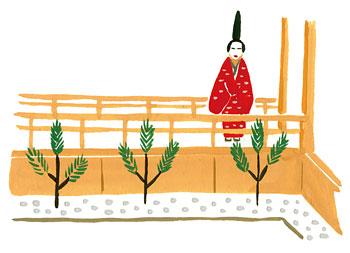
The Noh stage, which has a long history and is a venue for Noh performances, is divided into various types, such as those housed in the Noh theater, those set up outdoors, and those set up temporarily. As for the size of these Noh theaters, it seems that “a square with a side of three rooms (about 5.45 meters)” has been established since the time of Azuchi-Momoyama.
However, in reality, the size of each Noh stage is slightly different. There is no limit to the width or distance of the bridge that connects to the Noh stage and plays an important role in the performance. The standard range is 6 to 7 meters (about 11meters to 13 meters), but there are also many very small Noh stages with short bridges. There are many cases in which acts and dances are performed on the bridge in various performances, but even for the same performance and the same performer, the content can be finely changed according to the length of the bridge. The way the lingering sound that quietly leaves the stage will also change depending on the distance of the bridge. The difference in the distance between the bridges is deeply related to the way the performers express themselves.
Illustration: Hiroko Sakaki
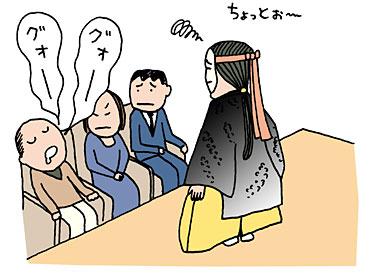
Many people will experience getting sleepy while watching Noh. Falling asleep is a category of “unavoidable”. Some people even say that some songs are so good that they invite people to sleep. However, fluttering your head and snoring are problems. Also, to prevent drowsiness, do not eat gum or candy because the sound and smell are annoying to the surroundings.
It is counterproductive to keep an eye on “I won’t sleep”. It’s not a bad idea to relax and immerse yourself in a world that is literally dreaming in your sleep. First of all, I want you to get in shape for the day so that you don’t watch the stage due to lack of sleep.
Illustration: Hiroko Sakaki